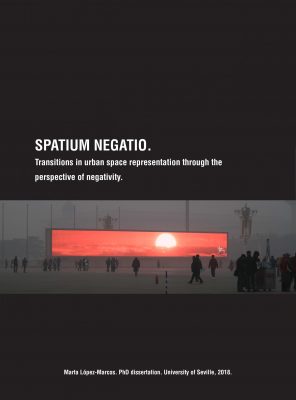
Autor: López Marcos, Marta
Director/es:
- Grahame Shame, David
- Pérez Escolano, Víctor
- Tapia Martín, Carlos
Fecha de lectura: 15 de Junio de 2018
Programa: Doctorado en Arquitectura
IDUS (descarga): https://idus.us.es/handle/11441/77047
Resumen
Modernity could be explained through the process of subordination of space to time. The Cartesian division between res extensa and res cogitans already established the differemiation of two independent realms: the first, abstraer, exterior and exceeding the realm of reason; the second, subjective and belonging ro the inner dimension of mind, through which knowledge and thought are possible. Western thought progressively associated these dimensions ro space and time respectively, the latter becoming the privileged realm of subjective interior, idemified with human spirit and the thinking subject. However, this historical negation of space was put into question after the so-called «spatial turn,» in which social sciences recovered space as a central category during decades of social, political and economic transformarions in a global scale. The understanding of space as a social product traversing multiple fields of knowledge led ro a certain displacement of architecture, which umil then had been considered ro be the practically exclusive discipline of space. After decades of engagement with the progressive socio-political project of Western modernity and its subsequent crisis during the last decades of the twentieth century, architecture retreated into questions of form and its autonomy as a discipline; a debate that persists today in cercain academic and professional circles. Under this scenario, now amplified with the global hegemony of (Western) capitalism, a revision of the category of space seems pertinent in order ro determine its contemporary relation ro the formal and socio-political dimensions of architecture. Although now deprived from the strength of dialectical approaches -harshly criticized by the major currems of comemporary philosophy-, the perspective of negativity and its multiple connotations may offer a renewed theoretical framework from which ro understand if space is still a relevam elemem for a contemporary architecture in crisis. In this regard, the field of urban public space, as an ideological construction that materializes in the city, appears as a fruitful field of study in which ro trace transitions between dominant conceptions of space during the last centuries through negations (undersrood as the overcomings of space from different areas: temporal, productive, visual .. . ); reverses (understood as counterspaces, the term coined by Henri Lefebvre ro designare alternatives ro abstraer, capitalist space), and the multiple spatial practices that configure and take place in this type of space, extending the purely architecmral and urban action.
The project is structured around the relations between dominam conceptions of space and the forms of exteriority, the main membranes through which Being spills out facing otherness beyond its subjective limits. Therefore, the articulation of the work responds to a series of back and forth drives: five movements and counter-movements towards the realms of the physical city, the body in space and the actual-virtual relations between human and non-human agents, interrupted by three seductiones from non-Western comexts (Beijing, Warsaw and Istanbul) to alter the prescribed path and put imo question rhe pervasive character of rhe notion of public space.


